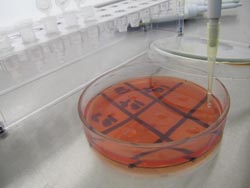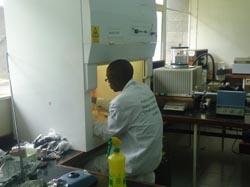Isaac Balume was Masters student under N2Africa and conducted his study at the University of Nairobi from 2011 to 2013. He was based at the MIRCEN Laboratory University of Nairobi where he did research on quality control of inoculant used on bean and soybean in Eastern and Central Africa. This resulted in a research paper on ‟Shelf-life of legume inoculants in different carrier materials available in East Africaˮ that recently was published on line: http://www.ajol.info. Two carrier materials; Dry filter mud recovered as sludge from crushing of sugarcane and commercial available horticultural vermiculite, inoculated with both strains Bradyrhizobium japonicum USDA 110 for soyabean (Glycine max) and Rhizobium tropici CIAT 899 for common bean (Phaseolus vulgaris), were assessed for their shelf-life in two contrasting storage temperature refrigeration at 4°C and room temperature at 24°C in comparison to BIOFIX the commercial available rhizobia inoculant. After 165 days of monitoring viable population of rhizobia differed significantly between the carriers and rhizobia strains (P˂0.05), we found that Rhizobium tropici CIAT 899 prepared with filter mud carrier achieve a shelf- life of 135 days and Bradyrhizobium japonicum USDA 110 contained over 109 cells g-1 for 105 days. Both of these results fall below the stated six months expiry period of BIOFIX. Replacing filter mud carrier with vermiculite, resulted in an inferior product; although, both more thorough sterilization and refrigerated storage, after 14 days curing stage improved the shelf-life of rhizobia in inoculant packet.
 |
Left: Drop plate method for quality control of inoculant Right: Isaac conducting quality control assessment |
 |
Therefore the results suggest that first the inoculant must be used during the growing season for which it was produced, and not carried over to the next, even when stored under refrigeration, second careful preparation of inoculants in laboratory through better sterilization of carrier material lead for increase rhizobia population for several days after injection.
Isaac Balume
